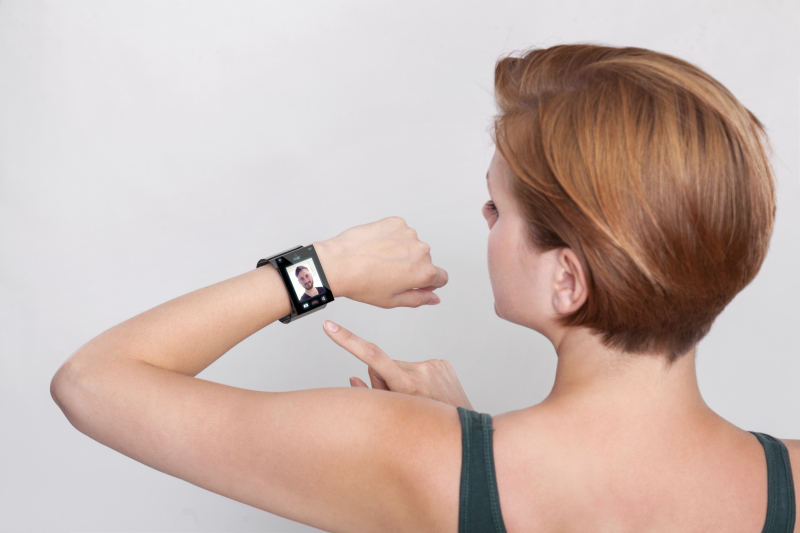The wait is over. BlackBerry unveiled BBM’s integration with Android Wear at Mobile World Congress (MWC) earlier this week. BBM is officially available on a wristwatch near you. You can receive alerts when new BBM messages come in, read your messages, respond using voice recognition and more. (See a demo from Consumer Electronics Show (CES) 2015 here.) More importantly, this is just the beginning of a new era in computing (read some of my more detailed thoughts on this subject at my LinkedIn blog).
Wearables in the Spotlight
“Wearable” seems to be this year’s tech buzzword, but the devices are arguably not new. Chest-strap heart rate monitors from Polar, Garmin, and others have been around for decades. More recently, Fitbit, Nike+ FuelBand, Jawbone, and others have brought computer-controlled activity-tracking wristbands and watches to market.
Perhaps the most famous—or infamous?—wearable so far is Google Glass, the “optical head-mounted display,” (or OHMD for short), that provides contextual information in the upper right corner of your field of vision. It can augment your real-world view with contextual information such as the time, temperature, or directions. The device is no longer available to the public, though Google said it will continue to work on future versions of Glass in secret. Many assumed that was a noncommittal way to say that Glass was effectively dead. Others hailed the technology, and predicted it would be back around again—and soon.
Sony is on the bandwagon, with a similar product called SmartEyeglass, and it doesn’t end here. Wearables have been a huge focus at tech conferences this year, including both CES and MWC. Here’s a great photo essay from Tech Republic to give you a sense of it. And of course, there’s a lot of speculation about Apple Watch, due out soon. Wearables don’t have to be gadgets that go on your wrist, either. They can also be clothing and accessory items.
Why All the Fuss?
While wearables may seem like nothing more than noise-making jewelry for early adopters (like myself), their future is very promising. Some even go so far as to say that wearables + the rest of the Internet of Things (IoT) = the future of computing. According to research firm Canalys, annual smartwatch shipments are estimated to grow to more than 28 million units by 2015, and more than 60 million by 2017.
Every time a new idea grabs headlines, there are experts who line up to pooh-pooh it. Ken Olson, founder of Digital Equipment Corp., famously said in 1977, “There is no reason anyone would want a computer in their home.” Business Insider has a fun collection of luminaries who dismissed Apple’s iPad.
Wearables for Consumers
While it’s not always easy to understand a new technology’s future application, it’s clear that wearables are already useful, and will quickly become even more so. For example, Android Wear smart watches try to predict what information you will want at any given time, with surprising accuracy. If your lunch meeting is coming up, your watch will give you directions to the restaurant. At 6 PM when you shut down your computer, your watch will provide traffic information for your commute home.
As mentioned above, many wearable devices collect data about the wearer: footsteps, heart rate, temperature, etc. Imagine if, at your annual check-up, your doctor could download all that information for the year, and use it to track your health, offer personalized suggestions to improve it, diagnose potential problems, and more. Just like the information social media sites collect, such data also has value to retailers, to service providers, to advertisers, as well as to you, the wearer. Gartner predicts that apps and services spawned by wearable user data could generate up to $5 billion by next year.
Business Applications
On the business side of things, some of the first companies to adopt mobile technologies will likely also embrace wearables. Delivery services could opt for wearable devices to track truck location, collect signatures, and more. Recent pilot programs outfit law enforcement personnel with wearable cameras that record their words and actions—with very positive results. The possibilities are endless.
Messaging and Wearables
Integrated with Android Wear, BBM users will be able to communicate faster and more discreetly when they’re out and about, and BBM will be available on a wide range of smart watches (see them here.) With BBM installed on your Android smartphone, BBM for Android Wear features will become available on the watch automatically. See if your phone is compatible.
BBM for Android Wear will allow you to:
- Receive alerts on the watch when new BBM messages come in, see the sender and discreetly preview messages;
- Read BBM messages in their entirety, navigate among messages and dismiss notifications with a simple swipe;
- Respond to messages hands-free (voice recognition) with Google Now, or choose from pre-defined messages to quickly send a response;
- Accept BBM invites from the watch without the need to access your smartphone.
Extending BBM to Android Wear is yet another way we’re increasing the usefulness of the platform, making it easier than ever to stay connected to friends, family and colleagues while you’re on the go.
